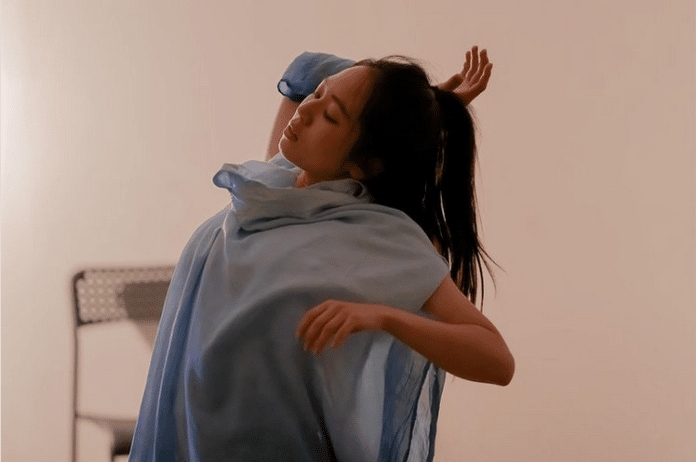
Blue is a solo contemporary dance performance by Mayu Shirai and Riku Otoyono. Mayu Shirai is an Osaka-born dancer and dance teacher who encountered street dance at an early age, moved to New York for a few years during university and deepened her connection with dancing during that time, participating in various workshops and collaborating with various dancers. Currently she lives in Osaka, where she has her dance school and collaborates with various artists. This was her first solo performance piece, an event that was held at Studio Port Mina, three performances during two days 29th and 30th of April, 2022. I went to see the first of these performances, which were based on improvisation upon the theme and overall thought out structure. Riku Otoyono is a solo musician who works under the title 夕方の豊野. In this performance he was set up in a corner with keyboard, guitar and laptop in a setting, that seemed enviably comfortable and fun for anyone who likes exploring sounds.
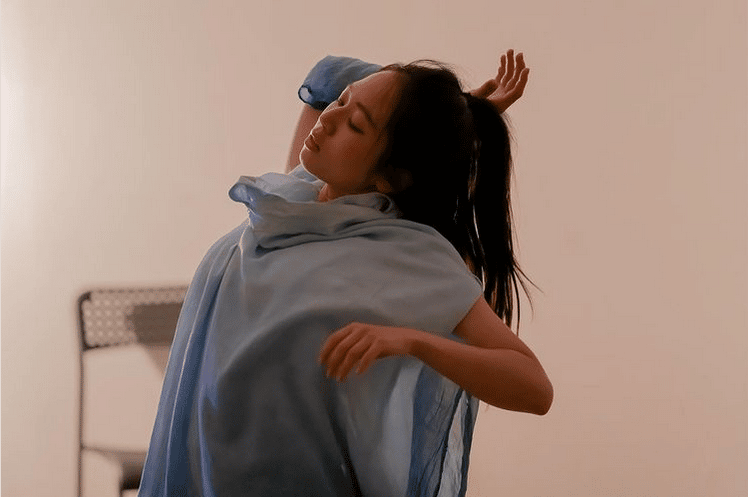
The setting is simple, yet brilliantly thought out. A small, one room dance-studio with white walls, a chair against the back wall, and on the chair a blue dress, colored by the artist herself, the knowledge of which somehow adds up to the experience of watching it as a work of art in its own right. The impression is strengthened by the bright light aimed at it, the music on the background, which contains sounds of harbor and percussive elements, low key, in a way ritualistic in this context. The room has three sources of light, the forementioned brighter, still dim light, blue light on the floor halfway through the stage, and on the floor in front of the stage a ribbon of small lights, under another blue cloth, which makes the whole scenario look like a wave frozen in time. The cloth on the chair, compared to these other elements, appears to be distant, sublime, out of this world, far from the audiences reach.
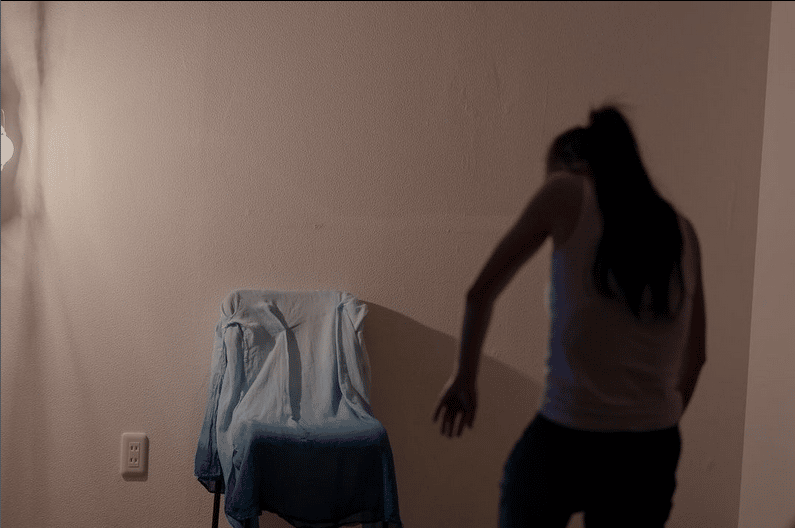
Soon the performance begins. The dancer stops right next to me before stepping over the frozen wave-like cloth and into the stage. What is instantly noticeable is how well the music and the movement go together in this moment. Lingering, slow, but somehow tense and anticipating. Both have the sensation of a wave, the ebb and flow, breathing in and out, and this also goes for the composition of the whole 50 minute performance. At first, the impression of the dress being out of reach seems to be somewhat valid. The dancer approaches, is caught up and pushed back to the beginning, but resiliently tries again.And again, and again. Eventually on the third or fourth try she reaches the blue cloth and the movements become more fluid, evoking elation and happiness, childlike joy over a rare finding, it is like first love, something pure and beautiful. The dress covers her face, she dances with it, but not in it, it is still an external thing, unknown, exciting. It invokes happiness and joy in beautifully natural way. Slowly, little by little, the dancer slips into the dress, wears it, becomes one with it.
This marks a dramatic change. Movements become sharper, panicking even, as if a painful transformation from one being into another. The music underlines this perfectly, it becomes noisier and more eruptive, the transofrming figure writhes and aches in front of the audience and in the climax everything goes suddenly dark and silent. The impact of this silence is an immence experience. The space is very well thought out in it’s intimacy. Little by little the movements begin again. The music begins again, this time from simple sounds that build up into a percussive loop. The blue light comes on. Mayu’s shadow becomes an important element from this point on. It seems like she is dancing with her shadow, that obediently follows her movements on the wall, she approaches it and distances from it, moves back and forth and seems to find some sort of acceptance and resolution within herself. The movements,little by little, become peaceful and more serene again. The music follows this, the marine soundscapes are soothing and blissful.
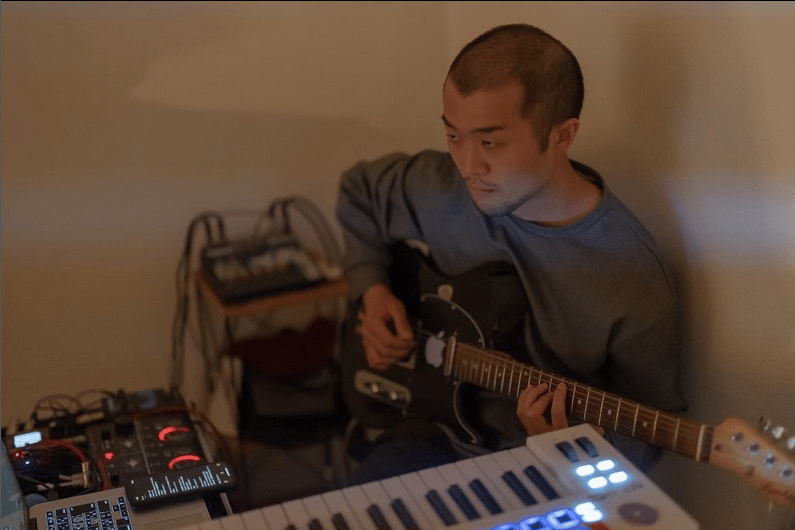
Then, as one has already forgotten they even existed, the small lights right at the edge of the stage come on and the blue light goes out. The impact of this is also intense, it seems like the simple lighting design of the whole performance goes from brighter and wider to darker and more intimate, like dwelwing deeper and deeper down into ones mind, into the most intimate and hidden parts of consciousness. Somehow this is also conveyed in the dance, as the movement and dancing is transformed into just being. Standing on the small lights, touching the blue cloth covering them, like being on the seashore by oneself, listening to the waves and thoughts, the intensity of this experience was such that I at times forgot to breathe. Then, another form of light is revealed, in it’s simplicity a smartphone flashlight, against which she shows two small paper ships, the shadows of which grow huge on the wall. She puts the light on the floor and moves the ships across the floor, so that the shadows sails on the wall. Then, became the small moment which I thought was the opening moment, 開くの瞬間。In every good performance, there is the small moment, sometimes intentional, sometimes coincidental, that is quite irrelevant, where the performance itself opens up, lik a flower to a full bloom. As the ship was left on the floor and Shirai reached for her phone, the ship’s shadow sailed through the wall without the effort of a helping hand, and that somehow seemed like a genious invention within the composition of the whole performance. Then, she placed the ship on the background, the other one slightly closer, and the shadows instantly became a landscape in their own right. The ships are left as they are, and as she stands next to them, her shadows strething huge over them on the wall, but not the least bit threatening, calm, protecting. She appeared as a goddess of the Sea, minimal movement giving this beautiful scene enough time to sink in.. What was overwhelmingly astonishing in the performance overall was how someone can express such tranquility although the excitement of the performance itself must be pulling body to a wholly different direction. Especially the facial expression transmitted nothing but peace and calmness. It was intense and beautiful experience. Somehow, the image of the shadows on the wall and the music has been etched deep into my consciousness and I notice myself still returning to them in some mundane and apparently unconnected moments.
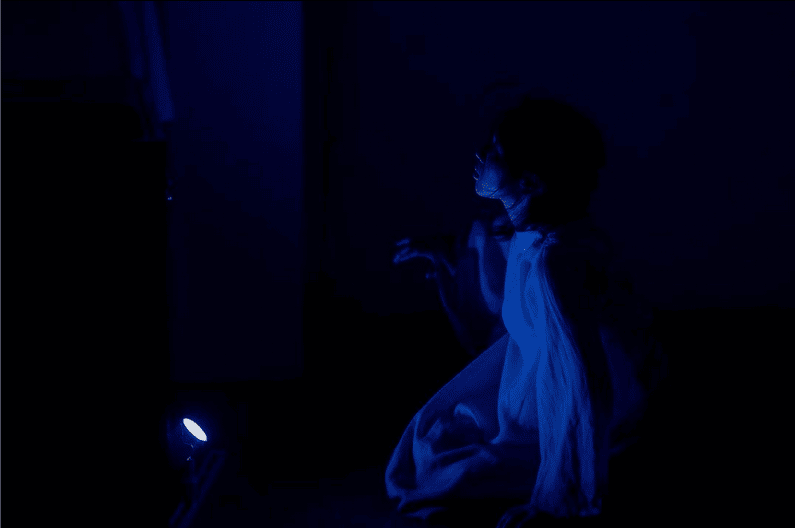
Then the final part, immensely impactful in it’s fragile beauty, how she returned to the shore and to the small lights, slowly took off the dress and left it at the shore. The piano with it’s Japanese scale based music seemed to underline this moment perfectly, I think every person in the audience felt it, this is humanity, existence, imminent, melancholic but beautiful goodbye that we signed up for with our first breath, that is something we all share and therefore innately understand, and this small moment with it’s every detail, how the dress slowly joined the other blue cloths, becoming one with it, inseparable, unrecognizable, the small, sad smile at the moment it floated down, all of that was pure poetry in dance and motion. How little is required for such an immense emotional impact. The lack of noise, the lack of big motions, just a simple act of letting go, subtle and beautiful little moment at the end of something intense. It made me think of many important aesthetic experiences in my life and I think I might be returning to this inside my head for years to come. This small moment probably sent the biggest shivers all over me, as it was somehow really huge in it’s uneventfulness. Maybe exactly because it followed dance, movement, it felt cathartic, beautiful, the end. The lights went back on after a short while, and it seemed like everyone needed a short while in order to return from where ever we were, in some commonly shared state of consciousness. I think, at least for a person like me, this is exactly the key element to transcendent artistic experience, to be transmitted from the ordinary state of consciousness into something shared, with the audience, with the performer, something we all explore and discover together. That is usually more apparent and imminent in performances based on improvisation and exploration, which is probably why I am driven towards that sort of approach to art.
As the performance came to an end I felt happy for Mayu. It was the first one of three scheduled performances taking place in two days. And I thought it was a brilliant start, not only for the performances, but for her future projects too. What I thought was particularly well thought out in the first place was the space and lighting, the composition of the whole experience. If it would have been a big budget production in a huge stage far from the audience, I think the impact would not have been quite the same. In a larger space, you need larger, more over the top action to fill the whole of the stage and space, unless your wanted effect is in fact the opposite, the sensation of smallness. But in place like this, every movement, every breath seems to count in a different way, everything matters. This way, the intimacy and especially the lights and shadows became elements that served the performance well in their own right. It was a triumph of innovation and creative thinking, instead of buying your way out of most problems there could be. Studio Port Mina was a great location for this piece, the audience was limited to few handfuls of people and it seemed to bring every person close together in the sold out performance.
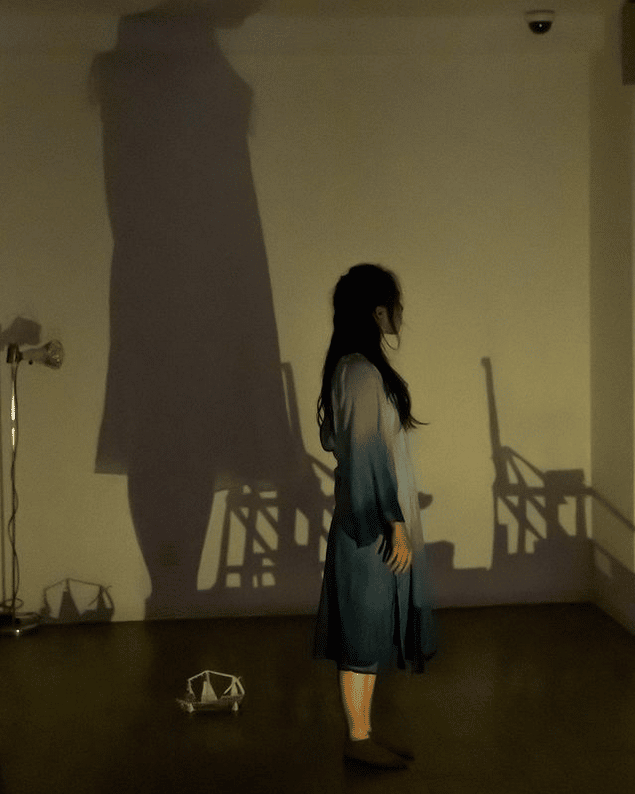
What I was thinking after the performance was how this was in many ways a triumph of creativity and innovation. The simple lighting composition especially was brilliantly thought out. The simplicity and minimalist approach worked perfectly in the context of the performance itself. The direction, forementioned order of use, the way lighting moved from brighter and more general to something darker and more intimate, everything seemed to work in the favor of the performance itself. The lighting was executed by Tomoya Ogishiba, who runs an art bar Maga-Yura in Noda, right across the JR loop line station. The practice performances for this performance were also held in Maga-Yura, and Mayu Shirai does also perform morning dances there on Monday mornings, 8-10 am, on the rooftop so it can be seen from the station platform. I also highly recommend visiting Maga-Yura, as it is one of the most soothing things possible to listen to ambient performances while watching the trains and the passengers go back and forth. But I am sure there will be another article about Maga-Yura later on.
In the absence of huge budget and huge stages the performance achieved interesting and thoroughly touching quality of intimacy that could not have been achieved any other way I think. If it had been a huge production on big stage, the movements might have been bigger, but maybe the impact had been different, somehow smaller. This way, on a small, confined space, the movements overall composition was much bigger in relation to the space available, and such was also the emotional impact of the movements. Every pause, every breath counts, when it is right in your face. The bigger the space, the more you need to do in order to fulfill it, unless one’s purpose is to underline the lack of something or the smallness of the performer. But I instantly thought, that Studio Port Mina was the perfect space for this performance. The studio is also available for dance classes and for rent for performances such as this.
Somehow, before the performance, with the cloth laid on the chair in mellow light, the tension seemed to start building up towards the back wall, towards the cloth, unachievable for the audience, first out of reach even for the performer, who eventually heroed her way towards it, redeeming us all from the tension of the unattainable. It seemed like an installation in its own right.
After the performance the atmosphere seemed relieved and relaxed, a local brewery had produced two special beers and a mikan juice that were sold on the occasion. Everybody seemed to have thoroughly enjoyed the performance and I as I left, I felt happy for going to see it, as it felt like Mayu’s journey as a dancer and performance artist had taken an important and interesting step towards something new, and this is just the beginning. I hope in the future she’ll be provided with the resources to make the productions exactly as she sees them, as it might become even globally interesting, but I was also glad for the smallness of this production, because it bred some really interesting and creative solutions to some practical problems that other’s would have tried to solve just by showing money into the problem until it disappears. I really prefer this sort of approach.
Luckily enough these performances were documented well enough, and a shorter, edited version of it is uploaded to Youtube, so I highly recommend you’ll take the time to watch it. There is also an extensive photo gallery of the performance uploaded to a separate instagram account. I am glad to provide this text as part of this sort of documentation, for I think contemporary dance is something that people might think of particularly difficult to approach if they come from the world outside of it. I can not say I would understand much of it, but especially in recent years I have maybe come to understood dancing in a much larger context than just “moving with the music”. We all have a body and it moves in a completely unique way, that is something we all share, so I think at best dance performances can help one to somehow understand their body and its movements and its effect on everyday consciousness in a pretty profound and sometimes emotionally touching way. For me personally this performance was really interesting, maybe even healing in some level, and it inspired me to think of things slightly differently, so I am honored I got to see it.
If you have any wishes of what sort of underground and marginal events or phenomenons you might be interested in reading about, I will take suggestions, but Osaka as a whole is always swarming nest of various different things, interesting people making some of the most interesting art on this planet and definitely funniest people to be around I have ever met, so I have quite a few ideas for the future. Still, as I am sometimes in the middle of the action, it might be difficult to distance myself from it, so I am asking whether the readers might also excuse a more “hands on” approach to for example event reports. You can contact me through this site or zenfilth@gmail.com .



















